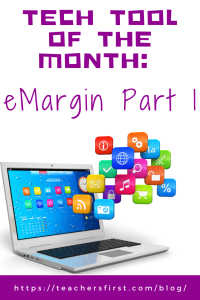eMargin is a web-based tool that allows you to annotate and collaborate. Users can upload text from their device, provide a website URL, or copy and paste text to annotate. You can use the menu on the right side of the screen to highlight text with your choice of color, add tags and notes, search for specific words and phrases, and create groups. Using groups allows more than one person to annotate, making this an excellent virtual collaboration tool for partner or group work. The homepage of this web tool offers a beneficial instructional video with additional information.
Applying the Triple E Framework
The Triple E Framework, created by Dr. Liz Kolb, states that “effective technology integration begins with good instructional strategies and not fancy tools” (tripleeframework.com). Dr. Kolb wrote a book on the topic, Learning First, Technology Second (ISTE, 2017), that lays out the three main uses for technology in education: to Engage, Enhance, or Extend learning goals. We can use this framework to decipher why we use specific classroom tools. Here is a rubric based on the Triple E Framework you can use to evaluate whether eMargin (or any other technology) is a good fit with your learning goals and whether you should use it in your lesson.
- Engage in learning goals: eMargin increases engagement by allowing students to highlight and annotate text on their own. Students actively learn as they read the text and note their thoughts and questions. There are little to no distractions, as eMargin has no gaming features or advertisements. Students are active rather than passive learners because they can independently read, highlight, and annotate on this website rather than just reading a textbook.
- Enhance learning goals: eMargin offers students scaffolding as they read, highlight, and annotate. Students can view the instructional video on the main page, follow the easy navigation on the right side, and scroll over the icons to view what each one represents. eMargin allows students to demonstrate a more sophisticated understanding of the content by annotating and sharing notes and enables them to present their learning in a way they could only do with technology. For example, students can collaborate and annotate together virtually, which fosters teamwork and can only be done using technology.
- Extend learning goals: Dr. Kolb describes extended learning as an opportunity for students to learn, connect, and collaborate outside the regular school day and as a way to create a bridge between school learning and everyday life experiences. eMargin can be used in a remote or asynchronous learning activity where students in a group collaborate and annotate together at school or home. eMargin can also help students prepare for everyday life experiences, as future jobs or coursework may require reading, highlighting, annotating, and collaborating to share information.
SAMR Connection
The SAMR Model, by Dr. Ruben Puentedura, suggests that technology implementation has four levels. We can use this model as a guideline to analyze how we use technology tools in the classroom. For example, you can use eMargin with your students at the substitution, augmentation, and modification levels, depending on what they’re doing.
- Substitution: The substitution level is the most basic level of SAMR and refers to when technology acts as a direct substitute without any functional improvements. An easy substitution example is having students read a PDF online and use eMargin’s highlighting feature rather than using a highlighter on a printed article.
- Augmentation: At the level of augmentation, the technology acts as a direct substitute and includes some functional improvements. We can take eMargin to this level by using the highlighting and annotating features to add digital notes onto a PDF or another digital text.
- Modification: The level of modification allows us to make (or modify) the activity into something more integrated with technology, meaning there is significant task redesign. We can reach this level by creating a group and having students collaborate on a text, adding their own notes, annotations, and highlighted areas. The finished text can be shared with the teacher by including them in the group.
Take advantage of Part 2 of the Tech Tool of the Month: eMargin, where we’ll discuss how to use the tool and provide classroom ideas. In the meantime, let us know how you have used eMargin in your education setting in the comment section below.


